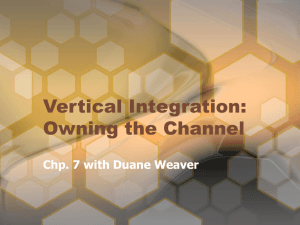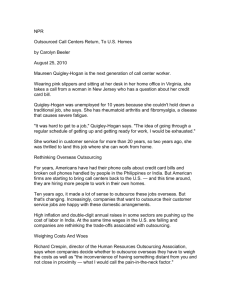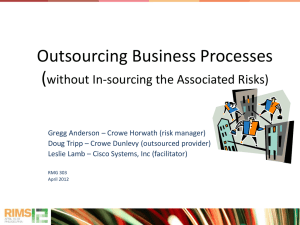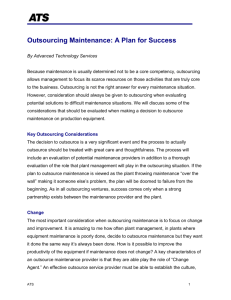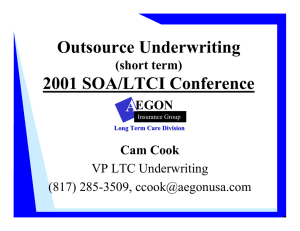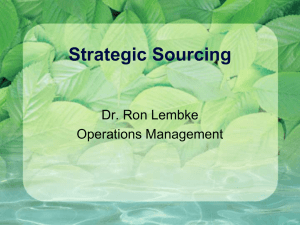Document
advertisement
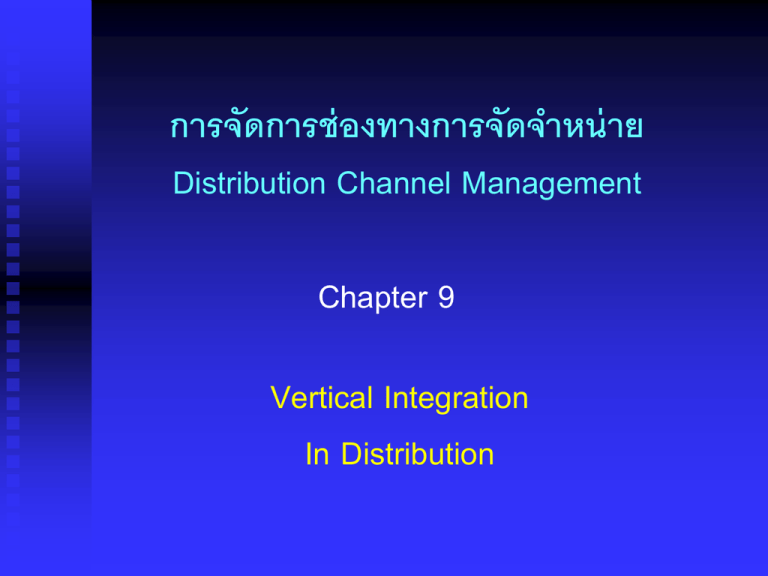
การจัดการช่ องทางการจัดจาหน่ าย Distribution Channel Management Chapter 9 Vertical Integration In Distribution Chapter 9 Outlines Learning Objectives - Understand vertical integration as different degrees from make to buy - Diagnose the reasons why channel players often integrate forward and backward - Explain six reasons why outsourcing is the preferred choice than vertical integration - Understand three situation why vertical integration is better choice than outsourcing - Define six categories of company-specific capabilities - Know reasons why vertical integration can cope with volatile environment - Learn how vertical integration reduce performance ambiguity Vertical Integration Points of Discussion - Why channel players would like to integrate forward or backward - Should all the distribution functions rolled into one company? - Should distribution flows be outsourced? Vertical Integration The Five Puzzles for Our Consideration - Why Whirlpool let another company perform the logistic function? - Why Luxottica take a risk to purchase LensCrafters acting as its own retailer? - Why Best Power dismantled its in-house operation and has turned to independent value-added resellers? - Why Jean Delatour integrate backward into the production of Jewelry related products? - Why supermarkets invest heavily in creating its own brands, private labels? Vertical Integration The Make or Buy Decision - It is a critical strategic choice in marketing channels - The manufacturer can gain much of its market intelligence from its channel - The decision once made is difficult to reverse and determines the firm’s future performance path - For downstream channel members, their decisions to integrate backward consume resources, put them into conflict with their other suppliers Vertical Integration Points of Discussion - Do Channel Members have to choose between purely Make or Buy arrangement? - If not, what are the other options remaining? Degrees of Vertical Integration Vertical Integration Cost and Benefits of the Choice to Make - Manufacturer assumes all the costs of distribution i.e. personnel costs, costs of all other channel flows (warehousing, logistics, customer outstanding) - Risk of the distribution operation - The responsibility of all actions - Benefits are control of operation, improvement of market share, return on investment Outsource Distribution Point of Discussion - Why outsourcing is the preferable choice among channel members? Outsource Distribution Six reasons to outsource the channel function to an outside party 1. Motivation – channel members aim for both positive (profit) and negative (fear of loss) motivation 2. Specialization – outsourcing allows each party to stick to their specialties 3. Survival of the economically fittest – there are no places for incompetent channel members as businesses are highly competitive, easy to enter and easy to exit Outsource Distribution Six reasons to outsource the channel function to an outside party 4. Economies of scale – justify by deep brand assortment from multiple manufacturers 5. Heavier market coverage – having assortment of goods to call on many customers more often 6. Independence from any single manufacturer – channel members act as independent counsel and know their customers well which can build strong customer loyalties Vertical Integration Forward Points of Discussion - What are the meaning of Company-specific assets? - How the Company-specific assets creates an economic rational for Vertical Integration option? Vertical Integration Forward Six types of Company – specific capabilities critical in distribution Intangible Capabilities 1. Idiosyncratic knowledge – specific knowledge about products, operating methods, product application 2. Relationships – connections between distributor personnel and personnel of the manufacturer or customers 3. Brand equity that derives from the channel partner activities two cases can be distinguished - the brand name that enjoys substantial brand equity - downstream channel members have a critical impact on the firm’s brand equity Vertical Integration Forward Six types of Company – specific capabilities critical in distribution Tangible Capabilities 4. Customized physical facilities – an important transaction specific asset as in the case of Amazon online bookseller 5. Dedicated capacity – warehousing, transportation, selling, billing and others 6. Site specificity – a location which is well suited to specific needs for the business Vertical Integration There are switching cost upon changing from vertical integration to outsourcing - accounting costs - opportunity costs - psychological costs - recruiting, relocating, training personnel, setting up infrastructure associated with new operation - setting up former employees in business as third-party providers of distribution services Vertical Integration Point of Discussion Why the manufacturer should integrate forward to meet the uncertain environment? Vertical Integration There are two schools of thought for vertical integration to cope with environmental uncertainty 1. Manufacturer needs to take control in order to cope with the environment 2. The uncertainty demands distributing through third parties and changing to another third party as the situation demands (committing to no one) How environmental uncertainty impacts vertical integration Vertical Integration Points of Discussion • What are the areas of unclear performance happening in channel distribution? • How vertical integration reduce performance ambiguity? Vertical Integration Vertical Integration is preferable as the way to reduce performance ambiguity - Unfamiliar market situation that there is no baseline to judge whether result are good or bad, particularly for innovation products - Difficult or impossible to gather relevant, timely, accurate result indicators
